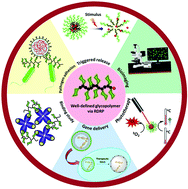Tailor-made glycopolymers via reversible deactivation radical polymerization: design, properties and applications
Abstract
Investigating the underlying mechanism of biological interactions using glycopolymers is becoming increasingly important owing to their unique recognition properties. The multivalent interactions between lectin and glycopolymers are significantly influenced by the glycopolymer length, epitope density, flexibility and architecture. Thus, careful regulation of structural parameters is important for specific and selective carbohydrate–lectin binding. The use of advanced synthesis techniques, such as reversible-deactivation radical polymerization (RDRP) and post-polymerization modification via “click” chemistry, has encouraged researchers to synthesize well-defined glycopolymers with various architectures. Apart from the biological research on lectin–glycopolymer interactions, glycopolymers are widely employed as synthetic biomaterials for various biomedical applications including targeted drug delivery, phototherapy, and bioimaging. Thus, extensive knowledge of new advances in glycopolymer research is necessary to carry forward biomaterial research to the next level. This review summarizes several structural features of glycopolymer–lectin interactions, the role of controlled polymerization methods in regulating those structural aspects and the recent applications of glycopolymers in biomedical research.



 Please wait while we load your content...
Please wait while we load your content...